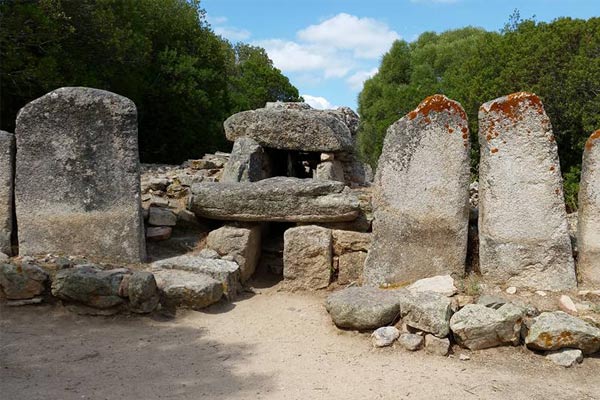Olbia is an ancient historic city, ready to surprise visitors who choose this town as their entry point to the island and capture the heart of anyone who explores its hidden corners. If you decide to reach Sardinia by ferry and arrive in Olbia, you will be impressed by its beauty from the very first moment.
Today we want to recommend the best places to visit in the city and in the surrounding area. Ready to take notes? Let’s begin!
What to see in Olbia?
The charm of this city is rooted in the past, as shown by its Nuragic, Phoenician, Greek and Roman remains. Over the centuries, Olbia has encountered many civilisations that contributed to its growth, making it an important reference point in Sardinia. Today, it is one of the main gateways for those wishing to reach the island thanks to its port, airport, commercial activity and tourism.
The historic centre
Just a short walk from the Isola Bianca Port lies the historic centre of Olbia. Particularly charming is Corso Umberto, with its early 20th-century buildings — many in Liberty style — shops, boutiques, cafés and restaurants.
Don’t forget to stop by the elegant Town Hall building, next to which you can see the remains of an ancient Roman forum.
Corso Umberto ends in Piazza Regina Margherita, a small and charming square surrounded by 19th-century buildings and cafés where you can take a pleasant break.
You will soon realise that the historic centre of Olbia is characterised by magnificent buildings and ancient churches that narrate the city’s long history.
And what about the surrounding area?
Archaeological sites in Olbia
The city is surrounded by numerous archaeological sites where you can discover the deeper roots of the island’s culture and origins. Sardinia is not just beautiful beaches, and exploring these sites around Olbia will show you exactly that.
Most of these locations are difficult to reach without your own vehicle or by renting a car at Olbia Airport.
Here are the sites we recommend for a perfect itinerary:
- Su Mont’e S’Abe Giants’ Tomb
- Pedres Castle
- the Roman Aqueduct
- the Riu Mulinu Nuraghe in Cabu Abbas
- the Sacred Well of Sa Testa
- the Punic Walls
1 – Su Mont’e S’Abe Giants’ Tomb
The Giants’ Tombs are examples of ancient burial structures typical of the Nuragic period. They feature a long burial chamber covered with horizontal slabs and a semicircular forecourt made of upright stone slabs. Unfortunately, this site lacks the tall, carved central stele found in other Sardinian locations.

2 – Pedres Castle
If you want to enjoy a stunning view over the Olbia plain, Pedres Castle is a must-see stop in your Sardinia tour.
The remains of the castle reveal one of the most interesting historical landmarks in the Olbia area. Once a judicial noble residence, its walls date back to the Middle Ages and were built using local stone in the 13th century.

3 – The Roman Aqueduct
In the Sa Rughittula area, in Olbia’s industrial zone, you can find the remains of the Roman aqueduct, built in the 1st–2nd century AD to carry water from Mount Cabu Abbas to the centre of the city.
Along Via Aldo Moro and Via Nanni you can see several segments of the aqueduct, while an ancient cistern is located in the underground area of the Locanda del Conte Mameli. It can be visited only upon request or during special events.
4 – The Riu Mulinu Nuraghe in Cabu Abbas
A visit to a nuraghe is a must for anyone exploring Sardinia. The Riu Mulinu Nuraghe in Cabu Abbas dates back to between 1300 and 1200 BC and consists of a central tower surrounded by defensive walls with two entrances. Thanks to its position, it is believed to have played a defensive role and served as an important lookout point over the Gulf of Olbia.
The nuraghe may also have had a religious function. A sacrificial pit was discovered on the site containing ceramic fragments and burnt bone remains.
5 – The Sacred Well of Sa Testa
The Sacred Well of Sa Testa, of Nuragic origin, features the typical geometric structure and staircase descending between perfectly cut stone walls, leading to a conical chamber. It was discovered around 1930 during a search for a water source.
The sanctuary is about 18 metres long and its external shape resembles a keyhole, symbolising the gateway between the world of the living and the dead. Around it, you’ll find a circular courtyard and a vestibule.

6 – The Punic Walls
Finally, the last stop we recommend is the Punic Walls in the centre of Olbia. These remains are nestled among modern buildings, but a quick look is enough to recognise them: massive squared stone blocks marking the site of an ancient city gateway.
The beaches near Olbia
After so many cultural stops, we certainly can’t forget the beaches. Here too, you’ll need a rental car to reach the coves quickly and enjoy a swim in the crystal-clear waters.
Among the best-known destinations near Olbia are Arzachena, Santa Teresa di Gallura, San Teodoro and, more generally, the Costa Smeralda. But there are also lesser-known beaches we recommend:
- Le Saline Beach
- Dottore Beach
- Porto Istana Beach, with its stunning view of Tavolara Island
- Punta Molara Beach
These are just some of the wonderful beaches in this area where you can relax and enjoy an extraordinary sea surrounded by breathtaking scenery.
Did you find our tips helpful? Great — now all that’s left is to plan your travel itinerary and book your rental car to reach every stop of your trip to Sardinia quickly and comfortably!


